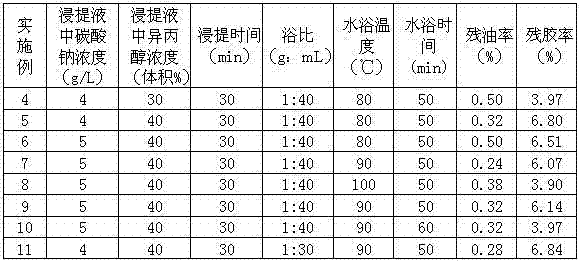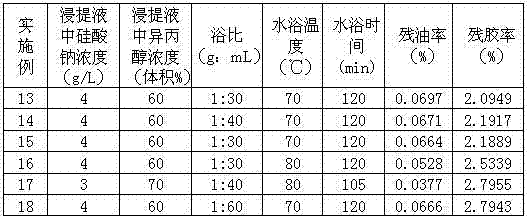Deoiling and degumming treatment method for waste bave
A processing method and technology for cocoon silk, applied in the field of degreasing and degumming treatment, can solve the problems of silk floss elasticity, warmth retention and service performance decline, long process flow, poor degreasing effect, etc., achieve good degreasing and degumming effect, and improve economical Benefit, the effect of reducing residual oil rate and residual glue rate
- Summary
- Abstract
- Description
- Claims
- Application Information
AI Technical Summary
Problems solved by technology
Method used
Image
Examples
Embodiment 1
[0024] After taking long spit and tearing pine and removing impurities, add an aqueous solution containing a certain concentration of sodium carbonate and isopropanol to long spit as the extractant, the volume concentration of isopropanol in the leachate is 20%, and sodium carbonate is a concentration of 6g / L, leaching for 30 minutes, the volume ratio of the mass of the leaching solution to the extraction solution is 1g: 40mL, that is, the bath ratio (w.v -1 ) at a ratio of 1:40, and then reacted for 70 minutes in a water bath at 80°C; after the reaction, take out the long spit, and wash the long spit with water at a temperature of 30-40°C for 3 times; finally, wash the long spit at 105°C Under drying for 3 hours, the long spit after deoiling and degumming was obtained. Test results: the residual oil rate of long spit is 0.39%, and the residual glue rate is 4.34%.
Embodiment 2
[0026] After taking long spit and tearing pine and removing impurities, add an aqueous solution containing a certain concentration of sodium carbonate and isopropanol to the long spit as the extractant, the volume concentration of isopropanol in the leachate is 20%, and sodium carbonate is a concentration of 5g / L, leaching for 30 minutes, the volume ratio of the mass of the long spit to the extraction solution is 1g: 50mL, that is, the bath ratio (w.v -1 ) at a ratio of 1:50, and then reacted in a water bath at 80°C for 50 minutes; after the reaction, take out the long spit, and wash the long spit with water at a temperature of 30-40°C for 3 times; finally, wash the long spit at 105°C Dry for 3 hours under the same conditions to obtain long spit after deoiling and degumming. Test results: the residual oil rate of long spit is 0.43%, and the residual glue rate is 3.90%.
Embodiment 3
[0028] After taking long spit and tearing pine and removing impurities, add an aqueous solution containing a certain concentration of sodium carbonate and isopropanol to long spit as an extractant, the volume concentration of isopropanol in the extract is 30%, and sodium carbonate is a concentration of 6g / L, leaching for 30 minutes, the volume ratio of the mass of the leaching solution to the extraction solution is 1g: 40mL, that is, the bath ratio (w.v -1 ) at a ratio of 1:40; then react for 40 minutes in a water bath at 80°C; after the reaction, take out the long spit, and wash the long spit with water at a temperature of 30-40°C for 3 times; finally, wash the long spit at 105°C Dry for 3 hours under the same conditions to obtain long spit after deoiling and degumming. Test results: the residual oil rate of long spit is 0.39%, and the residual glue rate is 5.07%.
PUM
 Login to View More
Login to View More Abstract
Description
Claims
Application Information
 Login to View More
Login to View More - R&D
- Intellectual Property
- Life Sciences
- Materials
- Tech Scout
- Unparalleled Data Quality
- Higher Quality Content
- 60% Fewer Hallucinations
Browse by: Latest US Patents, China's latest patents, Technical Efficacy Thesaurus, Application Domain, Technology Topic, Popular Technical Reports.
© 2025 PatSnap. All rights reserved.Legal|Privacy policy|Modern Slavery Act Transparency Statement|Sitemap|About US| Contact US: help@patsnap.com


